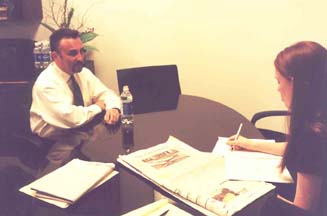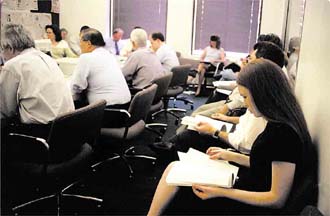Getting the ‘True Story’: Editors explain the rationale behind news decisions
After all the horrible articles I read in the Los Angeles Times that make teenagers look like killers, I figured that their editors must hate teens. What I discovered after visiting the L.A. Times for a day, however, was a completely different picture. I found out they are willing to give teens a chance—but I […]
After all the horrible articles I read in the Los Angeles Times that make teenagers look like killers, I figured that their editors must hate teens. What I discovered after visiting the L.A. Times for a day, however, was a completely different picture. I found out they are willing to give teens a chance—but I still don’t like the way the Times covers teens.
I interviewed Deputy Managing Editor Leo Wolinsky, the guy in charge of the front page, and sat in on an editorial meeting one afternoon in April. My visit was arranged by David Rickley, an L.A. Youth board member and longtime Times employee.
I’ll never forget talking to Wolinsky, who has worked at a reporter and editor for 25 years at the Times. Let me tell you, it felt awesome to sit in his office, showing him my research and asking him questions. So I feel sort of bad that I still don’t quite trust the L.A. Times.
As an example of negative coverage, I showed him the huge front-page headline about the Santana High School shooting. When he looked at it, I could see visible surprise on his face. "Why would that give us a bad rap for honesty or accuracy?" he asked me.
I told him, I could see why this is news. The problem is that it doesn’t reflect my reality, or the reality of 99 percent of my peers.
The Times is just reporting the news
His response: "We are going to continue to cover the news. We’re going to do it in a way—I hope—that’s balanced and fair."
Wolinsky explained, "We’re not driven by an agenda that says, ‘Make teens look bad.’ We don’t have an axe to grind. I don’t get a commission for selling newspapers. What we are trying to do is get the true story of what happened, and get people to read it."
I could see that we could never agree on this. His idea of telling the truth feels to me like distorting the truth.

Sara asked Deputy Managing Editor Leo Wolinskhy why front-page articles about teens are overwhelmingly negative.
Photos by Managing Editor Libby Hartigan
At the same time, he admitted that the Times staff is older and sometimes out of touch with youth issues. "We’re not good at reflecting what’s really going on with young people."
Before I went to the Times, I had this weird mental image of a small group of editors, sitting in a spacious room with huge glass windows overlooking the city, like rich powerful fat cats who call all the shots. Attending an editorial meeting gave me a different view. I found myself in a small dim room with an overhead projector and numerous newspapers pinned to the wall. A large group of editors, about 25, entered the room. The people who produce the news seemed like normal, down-to-earth people, not celebrities who are out of touch with the real world. They probably have teenagers of their own.
This was the daily 2:30 p.m. meeting, where editors of the Foreign, National, Business, Metro, and Sports sections decide what should go on the front page of the Times each day. They were deciding what would go on the front page on Wednesday, April 18.
The meeting got started. A 31-page packet of article summaries waited on each chair. The editors started summing up the articles they thought belonged on the front page. That day, everyone kept talking about "Izpal." I was confused until I realized that "Izpal" was a "slug," or one-word abbreviation, for an article on the Israeli-Palestinian conflict. The editors gave suggestions for the front page, including a study on the Asian population in New York, another about the death of City Councilman John Ferraro, another about Yahoo. The editors had to find a "lead" for the front page. They decided that the lead would be the Izpal story. Their main objective was not to show anything accusatory, but to report on the important news of the day. There weren’t any youth issues discussed that day.
The editors there respected me, even though I was younger. You’d think that with the headlines the Times reports, the editors would expect me to be some crazed teen ready to shoot them at any moment, but it wasn’t like that at all. I felt so powerful, sitting in the very room where people decided what was news, and what wasn’t.
A lot of the news that they chose for the front page wasn’t particularly interesting to me. As a young person, I honestly have to say that I don’t really care if "Two Vocal Russian Publications Are Silenced," or about "EPA to Keep Clinton Rule to Curb Lead"—both headlines for that day. I do care about the Israeli-Palestinean conflict, mostly because I’ve been to Israel. But then again, I don’t have a career or children of my own, and I don’t have much interest in world affairs.
Do they know what’s important to us?

Sara Hahn (seated at right) attended the daily 2:30 meeting where Los Angeles Times editors decide which stories will go on the front page.
I’m sure I’m not the only one who has criticized Wolinsky and the L.A. Times for misrepresenting a group of people. I think the L.A. Times probably gets a lot of criticism, and they have to have a pretty tough skin because of it. I guess that the Times can’t appease everybody who complains—it would be like one of those sitcoms where there’s a gay man, a black woman, an Asian guy and a white girl. It would be a nice try, but I’m not sure if it would be news. It would be kind of unreal.
If I were at the top, I would still print a big headline about the Santana High School shooting. But I wouldn’t then print follow-up articles about the danger and threat of teenagers. I still think that by reporting negatively about teens, the L.A. Times is creating a climate of fear and distrust. It bothers me that the Times doesn’t seem interested in taking any responsibility for this.
"The public depends on the media for its pictures of crime. Three-quarters (76 percent) of the public say they form their opinions about crime from what they see or read in the news, more than three times the number who state that they get their primary information on crime from personal experience. In a Los Angeles Times poll, 80 percent of respondents stated that the media’s coverage of violent crimes had increased their personal fear of being a victim."
—Off Balance: Youth, Race & Crime in the News, a study disseminated through Building Blocks for Youth at buildingblocksforyouth.org



